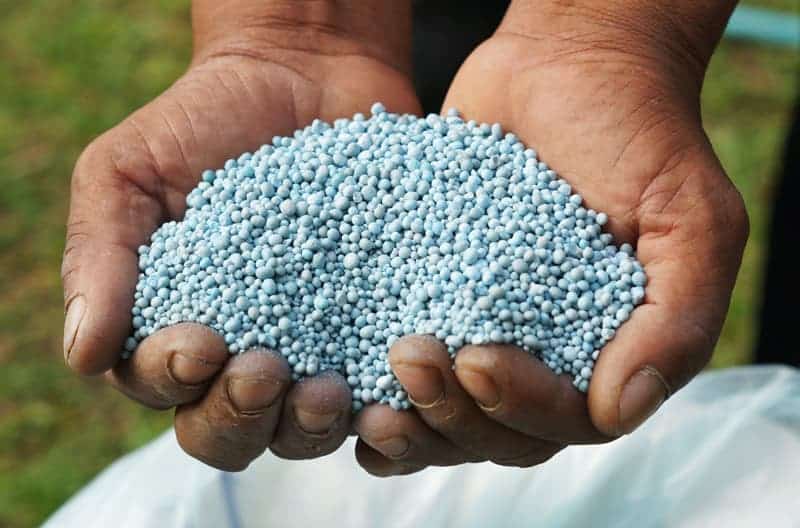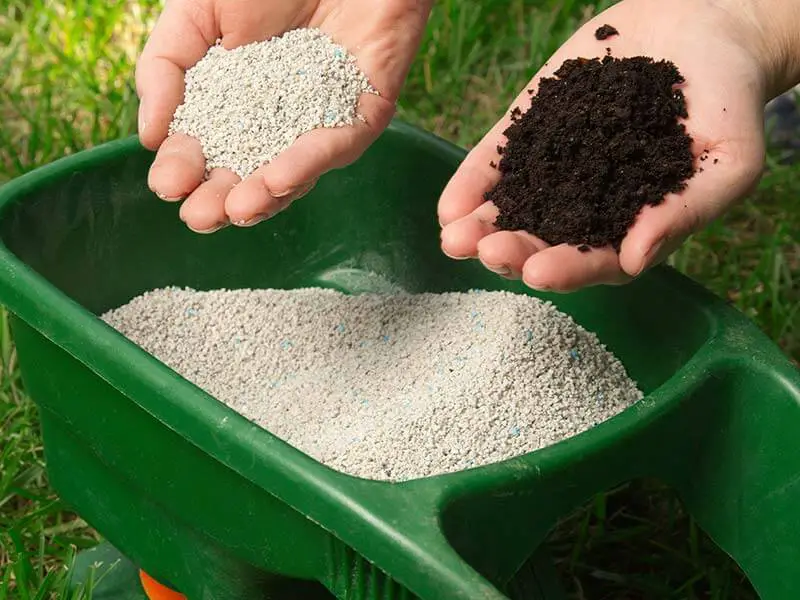What Is The Best Lawn Fertilizer For Early Spring
A longer-lasting fertilizer is typically healthier for your lawn in the spring, since it requires fewer applications. Nitrogen is the most important nutrient, but keep in mind that there are fast-release and controlled-release nitrogen sources. To check what the fertilizer contains, just look in the guaranteed analysis section on the back of the bag. Key terms to look for include controlled-release, slow-release, slowly-available, or water-insoluble nitrogen. Some specific types that may be listed include ureaform, sulfur-coated urea, polymer-coated urea, and IBDU . Several organic nitrogen sources are controlled-release if you prefer a more natural, less artificial choice. Most quality lawn fertilizers offer a balance of fast and controlled release sources to offer a fertilizer that will provide some quick color and some long-lasting nitrogen.
You May Like: Get Rid Of Creeping Charlie Naturally
Using A Drop Spreader
Choose a drop spreader for controlled fertilizer distribution. Overlap slightly on each pass to ensure you have adequate coverage, and don’t forget to close the hopper when you come to the end of a pass. You’ll typically pay more for a drop spreader, but if you’re tending a typical suburban-size lawn, it’s worth the investment. If you accidentally dump fertilizer onto your lawn, gather what you can, then use a stiff broom to spread out any remaining fertilizer as far as possible. Water it in well, and do so again a few days later to help move that nitrogen down through soil and out of the lawn’s root zone.
How Often Should You Use Weed And Feed
How Often Should You Use Weed And Feed? Weed and feed is a product that is used to control weeds and fertilize the lawn. It is typically applied once a year, in the spring.
Can you apply too much weed and feed? No, you cant apply too much weed and feed. However, you do need to be careful not to overapply it, as this can cause damage to your lawn. Follow the instructions on the package carefully to ensure youre applying the right amount.
How long should I water weed and feed? It depends on the type of weed and feed. Follow the instructions on the package.
Can I fertilize after weed and feed? Yes, you can fertilize after weed and feed. Fertilizing after weed and feed will help to replace the nutrients that were lost when the weeds were killed.
Don’t Miss: Wild Violet Herbicide
Fertilizing Warm Season Grasses
Warm-season grasses grow best when the temperature range between 80 and 95 degrees, which means their window for growth tends to be a lot narrower than their cool-season counterparts.
Plan on fertilizing this kind of lawn once a year in the spring, which will prep your grass for its relatively fast summer growth.
When’s The Best Time To Plant

The best time to plant depends on where you live and the type of grass youre planting. If you live in the North and are planting cool-season grass varieties, like Kentucky bluegrass, perennial ryegrass, or fescues, the best time to plant grass seed is the spring and again in the fall. Cool-season grasses grow most actively when the air temperatures are between 50 and 80 degrees F, the soil temperature is 50 to 65 degree F, and rain is plentiful. Cool-season grasses go dormant and do not grow during hot weather, when the soil temperature goes above 65 degrees F. Since this is common during the peak summer months, planting cool-season grass seed can result in poor seed germination or even seedling death.
On the other hand, if you live in the South and are planting warm-season grass varieties, like centipedegrass, zoysiagrass, bahiagrass, or bermudagrass, the best time to seed is late spring through mid-summer. Warm-season grasses are originally from tropical areas of the world and, once established, are able to thrive in scorching sun and high temperatures. They grow most actively when air temperatures are warm, between 70 and 90 degrees F. In addition, seeds need warmer soil temperatures than cool-season grasses to germinate .
Recommended Reading: How To Price Mowing Jobs
When To Put Fertilizer On Lawns
All lawns need fertilizer in early spring when the grass begins to green up. Your fertilization schedule for the rest of the season depends on the type of grass in your lawn, the type of fertilizer you use, and your climate. Most lawn seed is a mixture of several different types of grasses, and both spring and fall fertilization are appropriate.
The label on a bag of lawn fertilizer will recommend a schedule based on the type of fertilizer it contains. The label is your best guide to how often to apply the product and how much to use. As long as you dont overdo it and avoid fertilizing in the hottest part of summer, your lawn should thrive.
It Might Be A Good Idea To Get Your Soil Tested First
Before you choose a starter fertilizer for your new lawn, it might be prudent to get your soil tested. This test will indicate the levels of nitrogen, phosphorous and potassium in your soil.
Consequently, it will help you make a better decision as to which fertilizer to choose. Whether youre seeding or laying turf is also a determining factor.
For seeding, you need much closer levels of nitrogen and phosphorous for the young plants to develop. When laying turf, on the other hand, a greater amount of phosphorous is needed. This is because the turfs roots have been cut and therefore, need a little extra help to establish quickly.
Recommended Reading: Trugreen Mowing
What Is Fertilizer And Why Does Our Grass Need It
In a nutshell, fertilizer is food for your grass. It comes in a wide range of forms, but its primary function is to deliver the nutrients your lawn needs to survive.
The key macronutrients common fertilizers provide are nitrogen, phosphorus, and potassium.
However, plants actually require 17 essential nutrients to survive, so some fertilizers also include other micronutrients, such as iron, manganese, or sulfur for added benefits.
Whether its from leaching or poor conditions, most soils do not offer the level of nutrients needed to give your lawn that lush, green look. This is why including fertilizer with your regular maintenance plan can be critical to the overall health of your lawn.
Identify Your Lawn Grass
There is a multitude of grass varieties. You should know how to grow grass for lawn. Among all of them, you can find the major two types of lawn grass are grown in any region. These are-
Cool-season grasses
cool-season grass
These types of grasses are mainly grown well in low temperatures that means grow rapidly in early spring and early fall. If the temperature is high and the availability of water is low, these grasses may remain dormant. Major types of cool-season grasses are Bentgrass, Kentucky Bluegrass, Red Fescue, Annual, and Perennial Ryegrass, etc.
Best lawn fertilizer for early spring or cool-season grasses
You can get a good result by choosing the best lawn fertilizer for early spring. Commercial fertilizer can supply many of the nutrients for your lawn grass but among all of them, 3 are more crucial for your lawn grass. They are N , P , and K . You can use different kinds of combinations of these nutrients.
You are suggested to use 25-0-10 ratios of N-P-K fertilizer. Here 25-0-10 indicates the percentage of N-P-K. You can also use 15-5-10 or 20-5-10 ratios of N-P-K for your lawn in spring and fall.
Warm-season grasses
These types of grasses are tropical and grown well in warm temperatures that means these grasses grow well in mid-summer. These grasses are tough enough and become denser over time. Major types of warm-season grasses are Bermuda grass, Centipede grass, Kikuyu grass, and Zoysia grass.
Best lawn fertilizer for summer or warm-season grasses
Recommended Reading: Ringer Lawn Restore Lowes
How Soon Can I Fertilize After Overseeding
If you are overseeding an existing lawn, you should do so about 3 4 days after youve applied a regular lawn fertilizer. Alternatively, if your soil is low in phosphorous, you can apply a starter fertilizer before or immediately after seeding to give your new seedlings a boost once they germinate.
Best Time To Fertilize Lawn
Fertilizing in the morning allows the soil to take in the most nutrients, soak in the morning dew and take advantage of cooler temperatures. Thats the best time. Do not apply fertilizer on an abnormally hot day, not even in the morning. Wait until the weather cools back down to a normal temperature.
You can mow anytime after fertilizing with a granular treatment. With a liquid treatment, wait a day or two.
Shutterstock
You May Like: Lawn Mower Blade Sharpener Ace Hardware
When And How Often To Fertilize Lawn
Unless youre growing a low-maintenance lawn like buffalo or centipede grass, youll need to fertilize your lawn to keep it growing strong.
There are many crazy specific fertilizer schedules out there, but less is better when it comes to healthy lawns.
The best schedule for you depends on a few key details: your grass type and species, whether you go with organic or synthetic fertilizer, and how much effort you want to put into it.
You May Like: What Can I Spray On My Lawn To Kill Gnats
Be Wary Of Fertilizer Application Rates

Across the board, most fertilizer manufacturers are overzealous about their recommended dose and feeding schedule. Start light with half the recommended amount and rate of fertilizer. You can reapply if you dont like the results. Over a season or two, youll get a clear sense of how much it takes to get a healthy lawn.
A healthy lawn will be a relatively light shade of bright green. A lawn that is a deep, almost blackish green, has been very heavily fertilized. The dark green color comes from a lot of nitrogen-based fertilizer used on the lawn. It is highly likely that some of that fertilizer has run off into the streets, storm sewers, and has made its way into local streams and rivers.
Dont Miss: What Is The Best Lawn Sweeper
Recommended Reading: Weed Eater Brand Lawn Mower
How Often To Fertilize A Lawn
Differenttypes of grasses have their own growing season and you must make a differentfertilizer schedule for different types.
Schedule for cool-season grass
Cool-season grasses are actively grown in spring and fall when the average temperature fluctuates between 60 to 70 degrees Fahrenheit. You have to follow heavy fertilizer in fall and light fertilizer in early spring. You can use either slow-release or fast-release fertilizer.
You must apply these fertilizers before the very high temperature in summer when the grass will remain in dormant conditions. One pound of N-rich fertilizer is very effective for 500 square feet area of your lawn for cool-season grasses. Special cool-season fertilizers are available in the local market which facilitates your lawn to protect your grass during the winter season.
Schedule for warm-season grass
Warm-season grasses are actively grown when the average temperature fluctuates between 80 to 90 degrees Fahrenheit that means in late spring and summer. You might notice that your lawn grass turns green in the late spring and this is the best time to fertilize your lawn. Slow or fast release fertilizer can be used for these warm-season grasses.
Best time to fertilize lawn before or after the rain?
On the other hand, after heavy rainfall fertilization, gives an effective result for your lawn. It helps to reduce the chance of fertilizing running off that can not pollute near water sources and rest environment clean.
Best Fertilizers To Use
The best fertilizers to use are slow release. When you use slow release fertilizers, the grass will get green without growing too quickly. In the spring, mixtures of 20-5-10 are suitable to use. You can also perform a soil pH test before you start the process. Then, you can base the mixture off of your results. For example, if your pH tests come back with high potassium results, you can look for a combination that is lower in that category.
Call 215.799.2016 or fill out the contact form on the bottom of this page. We can answer any of your questions or set up a fertilization plan to keep your lawn healthy and looking great.
Don’t Miss: Tru Green Cost
When Should I Fertilize My Lawn In Spring And Fall
As well as knowing how often to apply fertilizer, its also key to know when to apply the fertilizer. To answer this question, it is recommended that you should always follow the instructions found on the label of your chosen fertilizer. However, following the general tips below will help you decide when to fertilize the lawn:
- Apply when the grass is actively growing.
- Apply when the soil is damp and the grass is dry.
- Apply when the grass is frost-free.
- Dont mow the lawn 3 days before or after applying the fertilizer.
Applying fertilizer outside of the period stated on the instructions as well as the guide above will run the risk of damaging your lawn so it is important to pay attention to this.
Dont apply fertilizers to your lawn during the winter months as the grass is dormant and will not achieve any better results. Applying fertilizer in the winter will increase the chance of polluting waterways by excessive run-off of the nutrients into nearby streams.
How To Apply Lawn Fertilizer
There are several ways to apply lawn fertilizer. Using a spreader provides more even coverage than fertilizing by hand. Hand fertilizing often results in burns where the fertilizer is concentrated and pale areas that dont get as much fertilizer as they should.
Broadcast or rotary spreaders are easy to use and dont cause striping like drop spreaders. The advantage to drop spreaders is that there is no chance of overthrow getting fertilizer on streets, sidewalks, or driveways. With a drop spreader, you have to make two trips over the lawn at right angles. For example, if you make your first trip over the lawn in a north-south direction, the second trip should run east to west.
After applying the fertilizer, water the lawn thoroughly. Watering rinses the fertilizer off the grass blades so that they wont burn, and it allows the fertilizer to sink down into the soil so it can get to work. Keep kids and pets off the lawn for the amount of time recommended on the label, which is usually 24 to 48 hours.
You May Like: Cost To Hydroseed 1/4 Acre
Why Too Much Fertilizer Is A Bad Thing
When more fertilizer is added than a lawn needs, the salts in the mixture will accumulate in the soil and potentially kill the grass. Living in an environment with too much salt makes it difficult for plants to absorb much-needed water from the soil.
How to Spot Fertilizer Burn
If youve ever seen an unhealthy lawn with patches or stripes of brown grass, you likely already know what fertilizer burn looks like. Fertilizer burn can be more of a concern when:
- You havent added enough water after fertilizing.
- You use a quick-release fertilizer.
- You apply fertilizer in extremely hot weather.
To avoid these issues, make sure to apply fertilizer during a cooler part of the day and water your lawn right after applying fertilizer.
Not only will the latter protect against fertilizer burn, but youll also be helping it be absorbed in the soil, which is right where you want it to be anyways.
You can also purchase fertilizer with slow-release nitrogen, which will avoid overwhelming your grass with salts before theyre needed.
Organic Vs Synthetic Fertilizer
While you may be tempted to pick up a bag of synthetic fertilizer at your local hardware store, they come with a ton of disadvantages to your lawn, your health, and the environment.
Synthetic fertilizers dont remain in the soil very long , require extra care to avoid nitrogen burn, encourage erosion and soil compaction.
They also rob the soil of organic matter and beneficial microorganisms and have negative health impacts on you, your family and pets, and any aquatic life in your nearby groundwater.
Organic fertilizer will last year-long, wont cause nitrogen to burn, aerate the soil, prevent erosion, add organic matter and support beneficial microorganisms, and are better for human and environmental health.
Suppose you want a low-maintenance lawn, transition to an organic lawn using organic fertilizers. The transition will require a few years of nurturing, but youll love it in the end.
I recommend reading Paul Tukeys essential guide, The Organic Lawn Care Manual, for a complete schedule for transitioning painlessly to organic.
Also Check: Thistledown Weed Killer
How Often Should You Apply Starter Fertilizer
If youre planting out a new lawn, you may be asking how often to apply starter fertilizer. This type of fertilizer is required to get your new grass off to a good start. It ensures that there are enough nutrients available to the young plants to encourage optimum growth.
So, what is starter fertilizer and why is it important?
Tips For Watering Your Lawn The Right Way13 Photos

Learn the ins and outs of lawn irrigation, including expert tips for efficient watering.
A day or two before applying fertilizer, water your lawn thoroughly. After grass dries, apply fertilizer. Then lightly water again. This second watering is vitally important, because it washes fertilizer off grass blades and into soil. You can also time fertilizer application between rainfalls to let rain wash fertilizer into soil. Just be sure you don’t fertilize before a downpour, or you may wind up with fertilizer washing away, especially if your lawn slopes. Avoid applying fertilizer during a drought when a lawn has browned or withered from lack of moisture.
Don’t Miss: Foxtail Weed Killer
